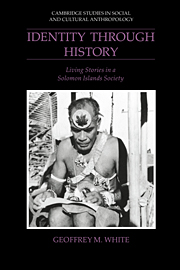Book contents
- Frontmatter
- Contents
- List of illustrations
- Preface
- Acknowledgments
- Orthography
- 1 Introduction
- I ORIENTING
- II TRANSFORMING
- III NARRATING
- IV REVITALIZING
- 9 Collisions and convergence
- 10 The paramount chief: rites of renewal
- 11 Conclusion
- Notes
- References
- Index
- Cambridge Studies in Social and Cultural Anthropology
10 - The paramount chief: rites of renewal
Published online by Cambridge University Press: 12 January 2010
- Frontmatter
- Contents
- List of illustrations
- Preface
- Acknowledgments
- Orthography
- 1 Introduction
- I ORIENTING
- II TRANSFORMING
- III NARRATING
- IV REVITALIZING
- 9 Collisions and convergence
- 10 The paramount chief: rites of renewal
- 11 Conclusion
- Notes
- References
- Index
- Cambridge Studies in Social and Cultural Anthropology
Summary
Given the prior history of the idea of the paramount chief, originating in the era of conversion and appearing sporadically during the colonial years, the most recent attempt to revive it offers an opportunity to observe cultural processes of long duration “up close.” The ceremony to install a new paramount chief at Sepi village in 1975 breathed new life into the symbol, but on the surface offered no new powers or duties to the man installed, Dudley Tuti. Like his uncle, Lonsdale Gado, it would be up to him to “make something of it,” to seize the moment, as it were. Although formally outside of government, Tuti was already “paramount” among local leaders in terms of personal reputation and influence. What, then, was the significance of the events of 1975 for those who so enthusiastically produced them?
The Sepi ceremony was both a crescendo of ritual activity and a prelude for events to come. As ritual, the event reconstituted a master narrative of Christian origins – one that resembles the various regional conversion stories discussed previously, but also encompasses them by offering an account of island-wide conversion focused on the person of the first major Christian chief. Part of ongoing political processes at that moment in time, the ceremony was the culmination of efforts to renew the category of the paramount chief, and also the beginning of another epoch of attempted revitalization – an era in which Dudley Tuti would be at the center of moves to reinvigorate traditional leadership (chiefs) generally.
- Type
- Chapter
- Information
- Identity through HistoryLiving Stories in a Solomon Islands Society, pp. 209 - 240Publisher: Cambridge University PressPrint publication year: 1991



